GMC SIERRA DENALI 2003 Workshop Manual
Manufacturer: GMC, Model Year: 2003, Model line: SIERRA DENALI, Model: GMC SIERRA DENALI 2003Pages: 428, PDF Size: 20.35 MB
Page 51 of 428
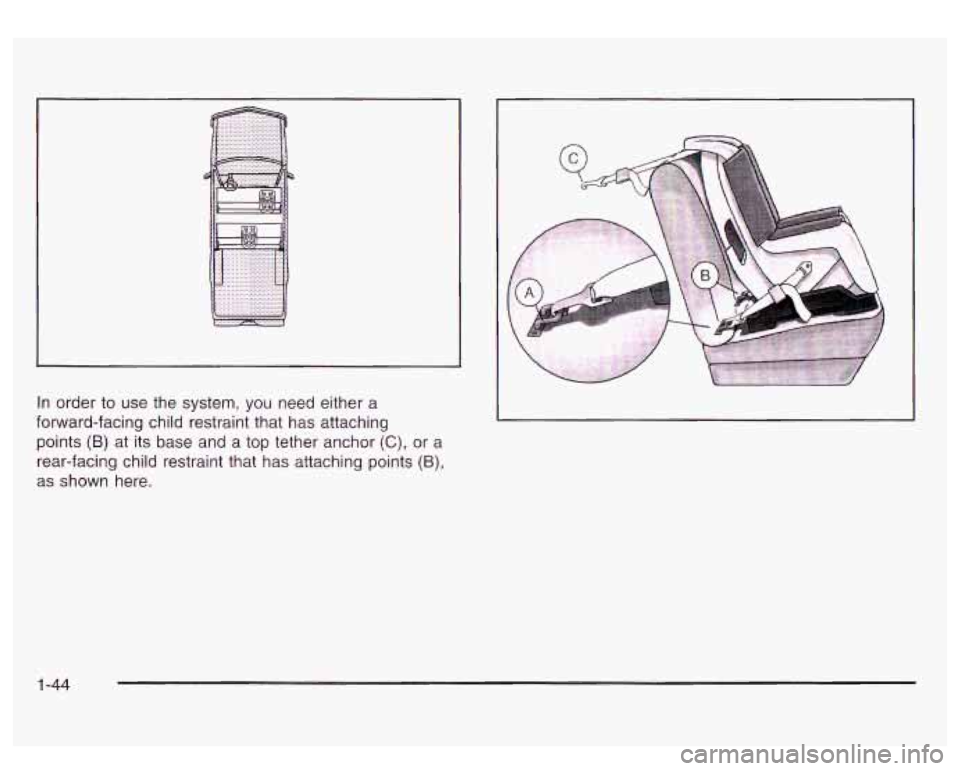
In order to use the system, you need either a
forward-facing child restraint that has attaching
points
(B) at its base and a top tether anchor (C), or a
rear-facing child restraint that has attaching points
(B),
as shown here.
1 -44
Page 52 of 428
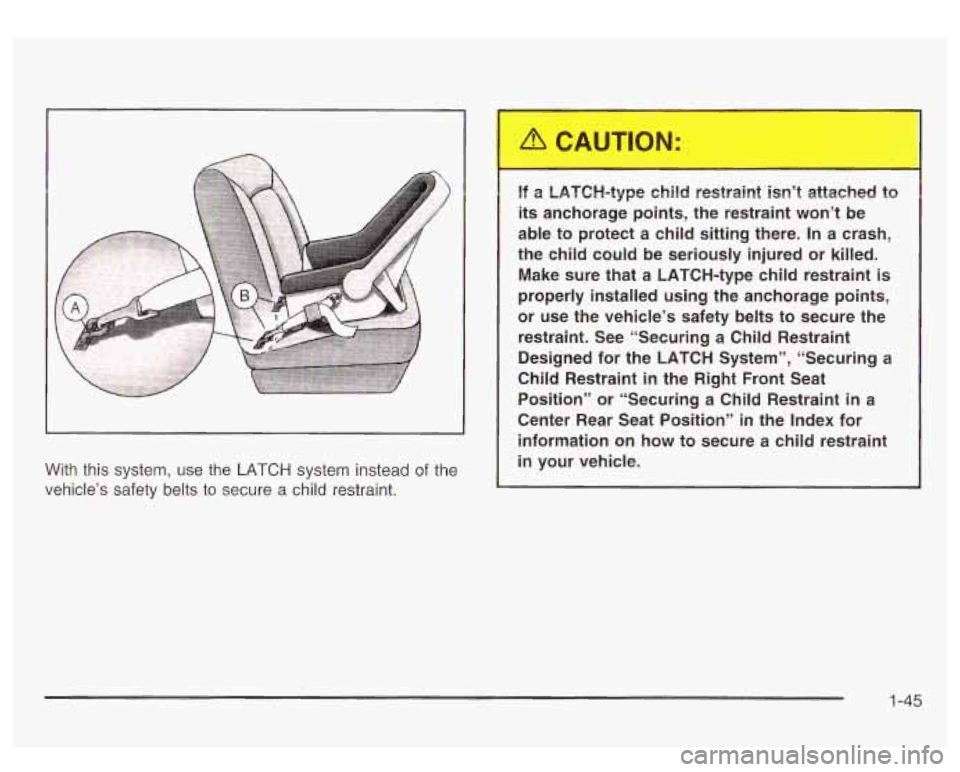
? With this system, use the LATCH system instead of the
vehicle’s safety belts to secure a child restraint. If a LATCH-type
child restraint
isn’t attached
its anchorage points, the restraint won’t be
able to protect a child sitting there. In a crash,
the child could be seriously injured or killed. Make sure that a LATCH-type child restraint
is
properly installed using the anchorage points,
or use the vehicle’s safety belts to secure the
restraint. See “Securing a Child Restraint
Designed for the LATCH System”, “Securing a
Child Restraint
in the Right Front Seat
Position” or “Securing a Child Restraint
in a
Center Rear Seat Position” in the Index for
information on how to secure a child restraint
in your vehicle.
1-45
Page 53 of 428
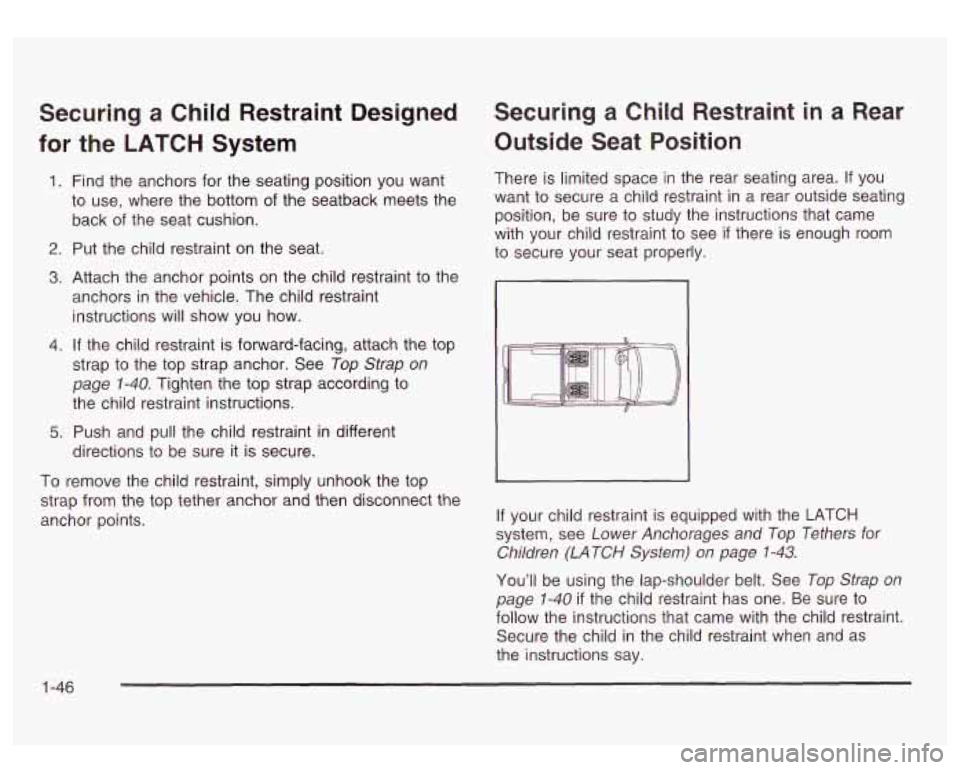
Securing a Child Restraint Designed
for the LATCH System
1. Find the anchors for the seating position you want
to use, where the bottom of the seatback meets the
back of the seat cushion.
2. Put the child restraint on the seat.
3. Attach the anchor points on the child restraint to the
anchors in the vehicle. The child restraint
instructions will show you how.
4. If the child restraint is forward-facing, attach the top
strap to the top strap anchor. See
Top Strap on
page 1-40. Tighten the top strap according to
the child restraint instructions.
5. Push and pull the child restraint in different
directions to be sure it is secure.
To remove the child restraint, simply unhook the top
strap from the top tether anchor and then disconnect the
anchor points.
Securing a Child Restraint in a Rear
Outside Seat Position
There is limited space in the rear seating area. If you
want to secure a child restraint in a rear outside seating
position, be sure to study the instructions that came
with your child restraint to see
if there is enough room
to secure your seat properly.
If your child restraint is equipped with the LATCH
system, see
Lower Anchorages and Top Tethers for
Children (LATCH System) on page 1-43.
You’ll be using the lap-shoulder belt. See Top Strap on
page 1-40 if the child restraint has one. Be sure to
follow the instructions that came with the child restraint.
Secure the child in the child restraint when and as
the instructions say.
1-46
Page 54 of 428
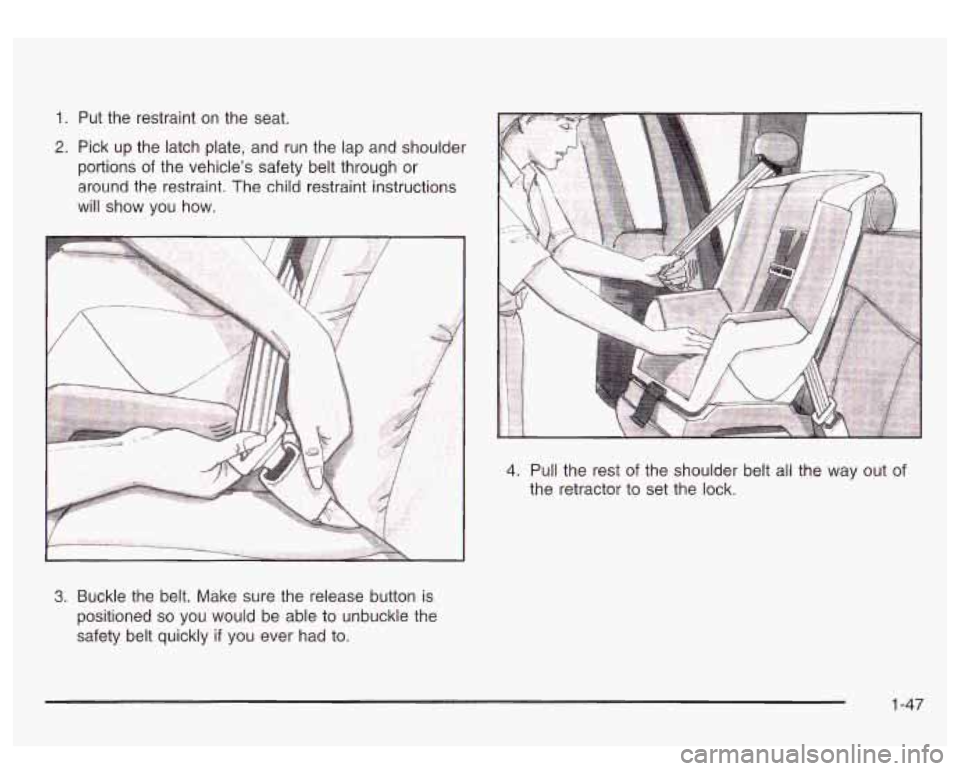
1. Put the restraint on the seat.
2. Pick up the latch plate, and run the lap and shoulder
portions
of the vehicle’s safety belt through or
around the restraint, The child restraint instructions
will show you how.
4. Pull the rest of the shoulder belt all the way out of
the retractor to set the lock.
3. Buckle the belt. Make sure the release button is
positioned
so you would be able to unbuckle the
safety belt quickly if you ever had to.
1-47
Page 55 of 428
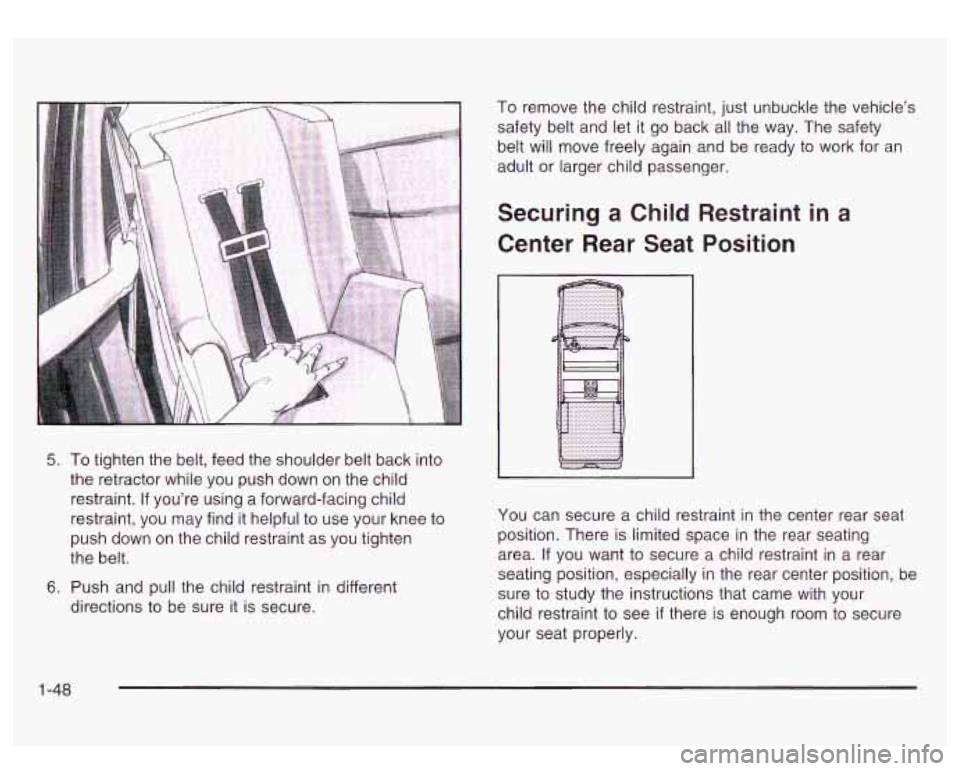
5. To tighten the belt, feed the shoulder belt back into
the retractor while you push down on the child
restraint.
If you’re using a forward-facing child
restraint, you may find
it helpful to use your knee to
push down on the child restraint as you tighten
the belt.
6. Push and pull the child restraint in different
directions to be sure it is secure.
To remove the child restraint, just unbuckle the vehicle’s
safety belt and let
it go back all the way. The safety
belt will move freely again and be ready to work for an
adult or larger child passenger.
Securing a Child Restraint in a
Center Rear Seat Position
You can secure a child restraint in the center rear seat
position. There is limited space in the rear seating
area. If you want to secure a child restraint in a rear
seating position, especially in the rear center position, be
sure to study the instructions that came with your
child restraint to see
if there is enough room to secure
your seat properly.
1-48
Page 56 of 428
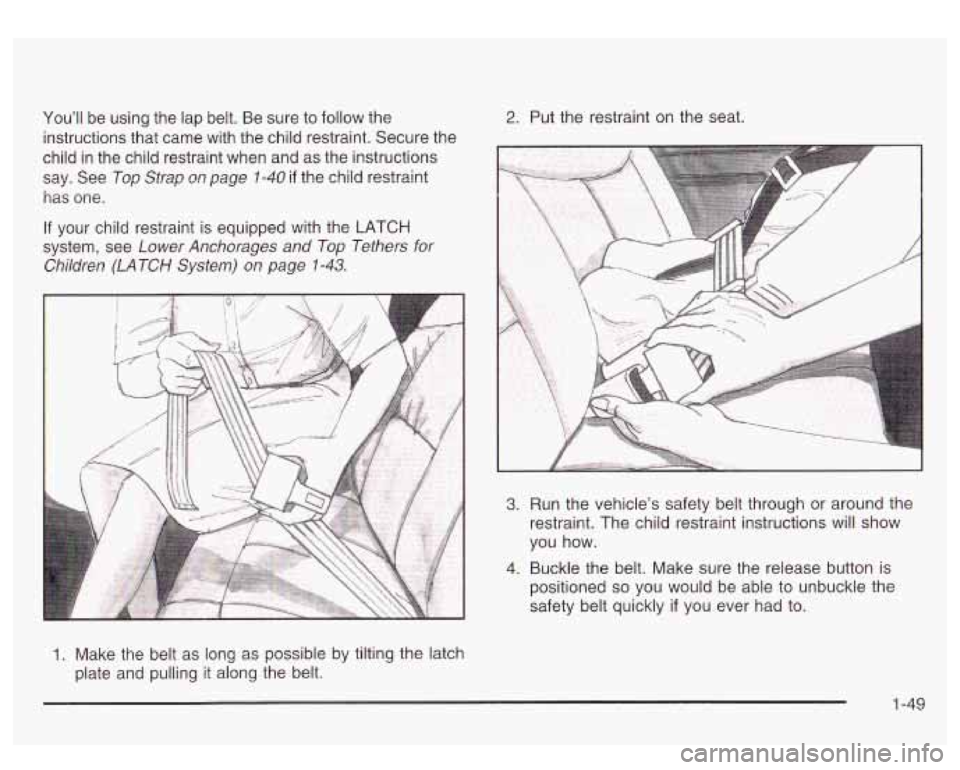
You’ll be using the lap belt. Be sure to follow the
instructions that came with the child restraint. Secure the
child in the child restraint when and as the instructions
say. See
Top Strap on page 1-40 if the child restraint
has one.
If your child restraint is equipped with the LATCH
system, see Lower Anchorages and Top Tethers for
Children (LATCH System)
on page 1-43.
2. Put the restraint on the seat.
3. Run the vehicle’s safety belt through or around the
restraint. The child restraint instructions will show
you how.
4. Buckle the belt. Make sure the release button is
positioned so you would be able to unbuckle the
safety belt quickly
if you ever had to.
1. Make the belt as long as possible by tilting the latch
plate and pulling it along the belt.
1 -49
Page 57 of 428
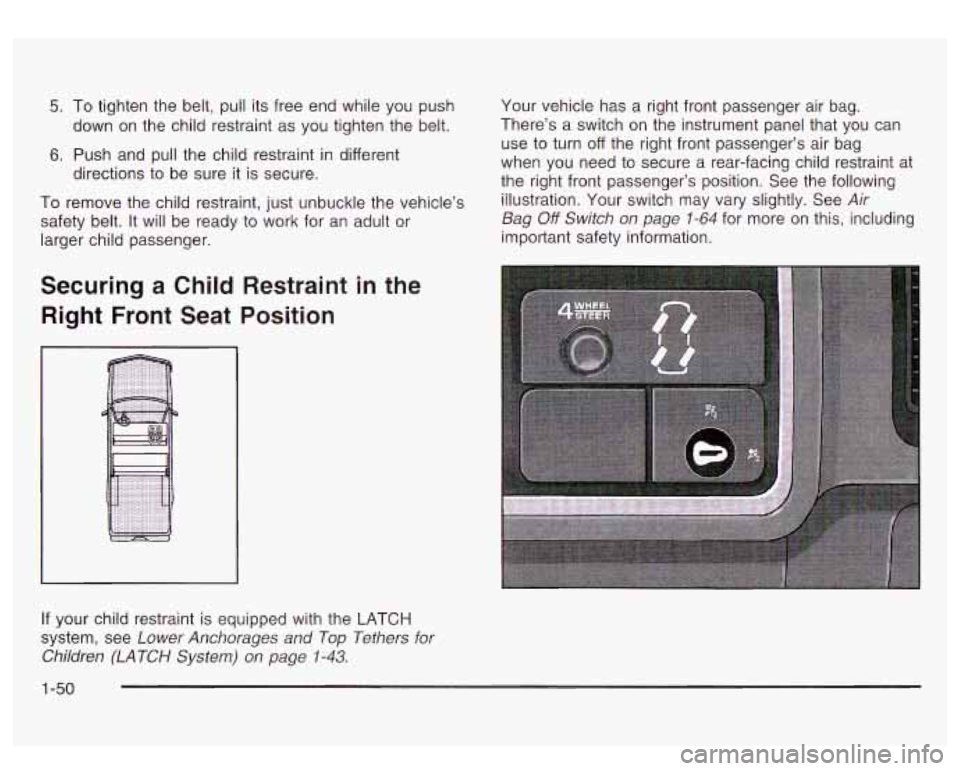
5. To tighten the belt, pull its free end while you push
down on the child restraint as you tighten the belt.
directions to be sure it is secure.
6. Push and pull the child restraint in different
To remove the child restraint, just unbuckle the vehicle’s
safety belt. It will be ready to work for an adult or
larger child passenger. Your
vehicle has a right front passenger air bag.
There’s a switch on the instrument panel that you can
use to turn
off the right front passenger’s air bag
when you need to secure a rear-facing child restraint at
the right front passenger’s position. See the following
illustration. Your switch may vary slightly. See
Air
Bag
Off Switch on page 1-64 for more on this, including
important safety information.
Securing a Child Restraint in the
Right Front Seat Position
If your child restraint is equipped with the LATCH
system, see Lower Anchorages and Top Tethers for
Children (LATCH System) on page
1-43.
1-50
Page 58 of 428
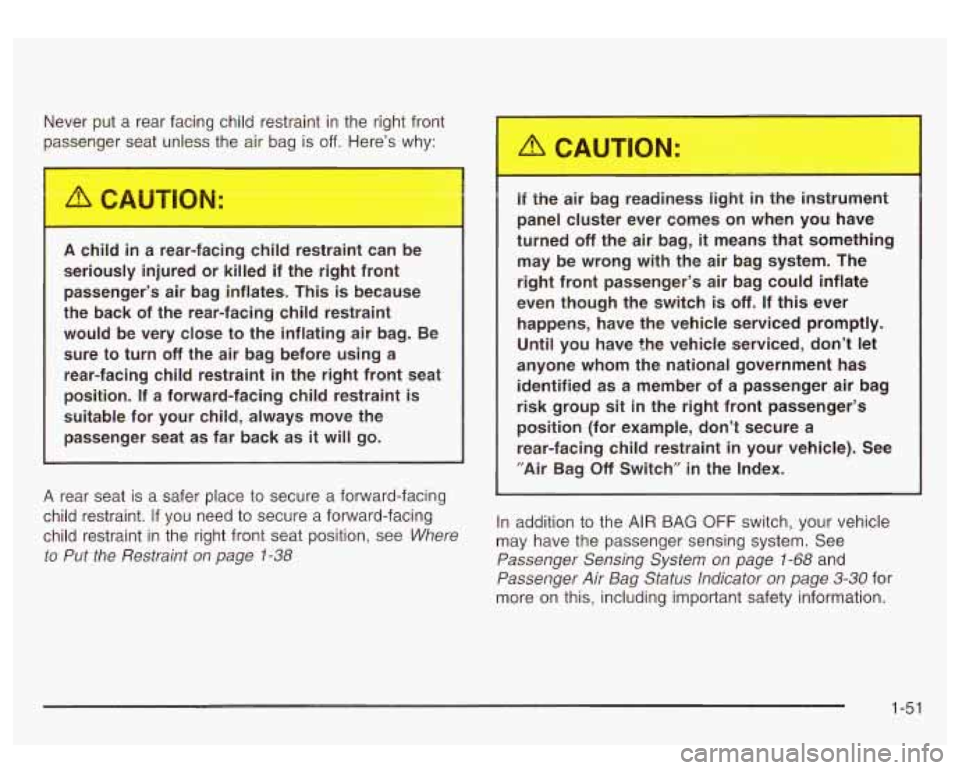
Never put a rear facing child restraint in the right front
passenger seat unless the air bag is
off. Here’s why:
A child in a rear-facing child restraint ca
seriously injured or killed if the right front passenger’s air bag inflates. This is because
the back of the rear-facing child restraint
would be very close to the inflating air bag. Be
sure to turn
off the air bag before using a
rear-facing child restraint
in the right front seat
position. If a forward-facing child restraint
is
suitable for your child, always move the passenger seat as far back as
it will go.
A rear seat is a safer place to secure a forward-facing
child restraint. If you need to secure a forward-facing
child restraint in the right front seat position, see
Where
to Put the Restraint
on page 1-38
If the air bag readiness light in the instrument
panel cluster ever comes on when you have
turned
off the air bag, it means that something
may be wrong with the air bag system. The
right front passenger’s air bag could inflate
even though the switch
is off. If this ever
happens, have the vehicle serviced promptly.
Until you have the vehicle serviced, don’t let
anyone whom the national government has identified as a member of a passenger air bag
risk group
sit in the right front passenger’s
position (for example, don’t secure a
rear-facing child restraint
in your vehicle). See
”Air Bag Off Switch’’
in the Index.
In addition to the
AIR BAG OFF switch, your vehicle
may have the passenger sensing system. See
Passenger Sensing System on page 1-68 and
Passenger Air Bag Status Indicator on page 3-30 for
more on this, including important safety information.
1-51
Page 59 of 428
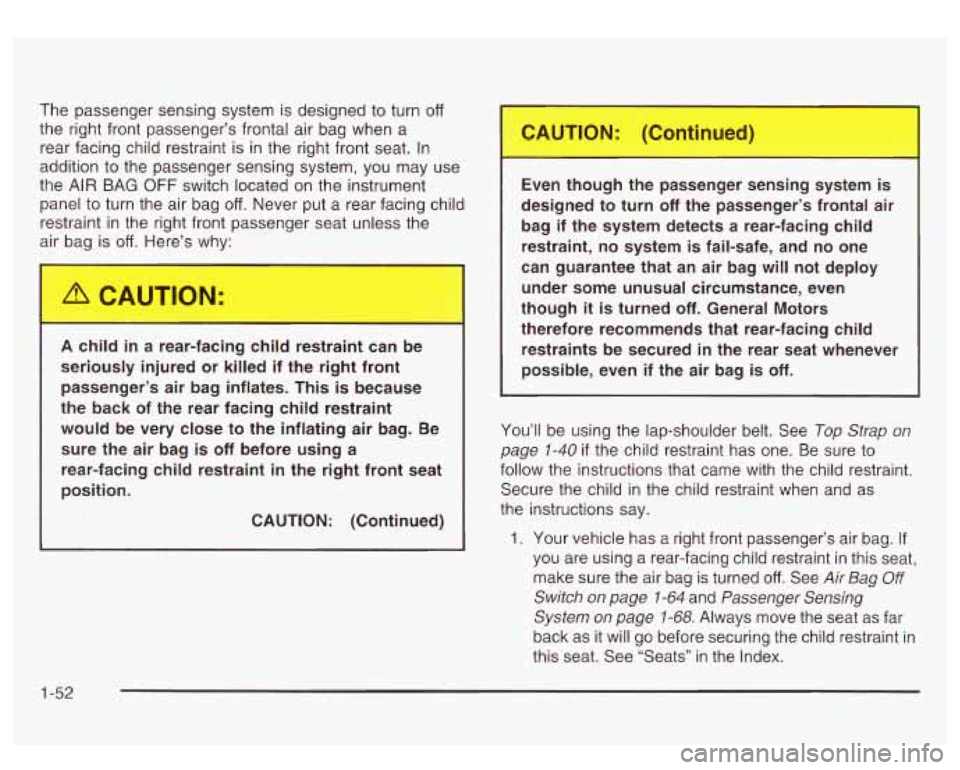
The passenger sensing system is designed to turn off
the right front passenger’s frontal air bag when a
rear facing child restraint is in the right front seat. In
addition to the passenger sensing system, you may use
the AIR BAG
OFF switch located on the instrument
panel to turn the air bag
off. Never put a rear facing child
restraint in the right front passenger seat unless the
air bag is
off. Here’s why:
A child in a rear-facing child restraint can be
seriously injured or killed if the right front
passenger’s air bag inflates. This is because
the back of the rear facing child restraint
would be very close to the inflating air bag. Be
sure the air bag
is off before using a
rear-facing child restraint
in the right front seat
position.
CAUTION: (Continued)
’ Even though the passenger sensing system is
~ designed to turn off the passenger’s frontal air
~ bag if the system detects a rear-facing child
restraint, no system is fail-safe, and no one
can guarantee that an air bag
will not deploy
under some unusual circumstance, even
though
it is turned off. General Motors
therefore recommends that rear-facing child restraints be secured in the rear seat whenever
possible, even if the air bag is
off.
You’ll be using the lap-shoulder belt. See Top Strap on
page
1-40 if the child restraint has one. Be sure to
follow the instructions that came with the child restraint.
Secure the child in the child restraint when and as
the instructions say.
1. Your vehicle has a right front passenger’s air bag. If
you are using a rear-facing child restraint in this seat,
make sure the air bag is turned
off. See Air Bag Off
Switch on page 1-64 and Passenger Sensing
System
on page 1-68. Always move the seat as far
back as it will
go before securing the child restraint in
this seat. See ‘Seats” in the Index.
1-52
Page 60 of 428
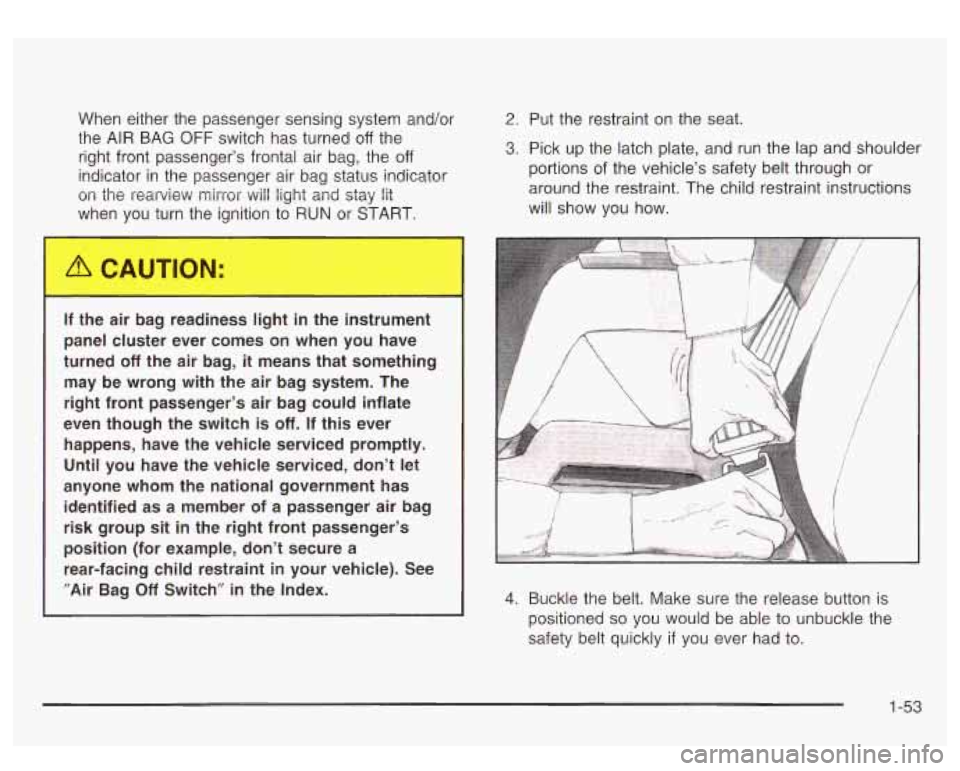
When either the passenger sensing system and/or
the AIR BAG
OFF switch has turned off the
right front passenger’s frontal air bag, the
off
indicator in the passenger air bag status indicator
on the rearview mirror will light and stay lit
when
y-” turn the ignition to RUN or START.
2. Put the restraint on the seat.
3. Pick up the latch plate, and run the lap and shoulder
portions
of the vehicle’s safety belt through or
around the restraint. The child restraint instructions
will show you how.
If the air bag readiness light
in the instrument
panel cluster ever comes
on when you have
turned
off the air bag, it means that something
may be wrong with the air bag system. The
right front passenger’s air bag could inflate
even though the switch
is off. If this ever
happens, have the vehicle serviced promptly.
Until
you have the vehicle serviced, don’t let
anyone whom the national government has identified as a member of a passenger air bag
risk group sit in the right front passenger’s
position (for example, don’t secure a
rear-facing child restraint
in your vehicle). See
”Air Bag
Off Switch” in the Index. 4. Buckle the belt. Make sure the release button is
positioned
so you would be able to unbuckle the
safety belt quickly
if you ever had to.
1-53